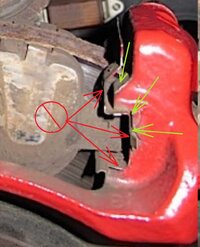The Single BIGGEST Problem with suffering from Asymmetrical Braking resulting in the Steering Wheel Pulling either to the Left or the Right occurs when
any type of Brake Lube is mis-applied in the WRONG Positions. So besides thoroughly cleaning and re-lubricating the Caliper Slide Pins... the same Quality Brake Lube MUST be applied
BEHIND the Stainless Steel Brake Pad Inserts,
This should be done only AFTER the Cast Iron Caliper Brackets are either treated using a Wire Wheel or by Sand Blasting to
Remove the Build Up of Thick Rusted Oxidized Material and NOT IN FRONT on the S/S Friction Reducing Inserts .
Those Stainless Steel Inserts NEVER require Brake Lubrication on their exposed "Face Up" areas where the Mild Steel Rectangular Brake Pad Guides make direct contact and hold the Pads in the confines of the Bracket(s).
The reason for this is because over time, exposure to Road Salt, Snow and Water Submergence... the areas
in between the S/S Inserts and the Cast Iron Carrier Brackets
WILL Rust and Flake up over time. This means that gradually the Ferric Rust expands OUTWARDS and puts pressure on the undersides of both S/S Inserts.
This pressure can increase, such to the extent as to Squeeze Down on the Mild Steel Brake Pad Rectangular Ends and BIND the Brake Pads solidly against the face of the Disk Rotor, either on one or BOTH sides, but generally more on one side than the other.
With each incidence of applying the Brakes... the Pad on the side suffering with the greatest amount of close contact WILL remain in there as the Friction increases between those areas. This causes over-heating and the premature wear of the Disk surface(s) and the Brake Pads... again...tending to be more on One Side than the Other. Thus the Binding Brake ALWAYS Grabs and resists the Disk Surface FIRST each and every time the Brakes are applied. Naturally, the Steering Pulls in the direction of that friction of the "stuck" Brake Pads.
This
"Rust Swelling" problem can become so extreme as to require that the Old Brake Pads must literally be Hammered loose. The Attached Disk Brake Exemplar Image below Illustrates precisely WHERE to apply the
Permatex Extreme Ceramic Brake Lube marked with
GREEN Arrows... versus... and contrasting those point where this material should NOT have that Lube on the places marked with
Red Arrows:


You can watch how Eric "O" from The South Main Auto Channel Re-Builds the Front Brakes on a GM Truck from the point where he deals with this issue at 20:45 into this 40 Minute Video.
Please note that he is also using the Permatex Ceramic Extreme Brake Parts Lubrication and explaining the CORRECT Brake Component Locations for its Proper Use during this Repair:
 photos.app.goo.gl
photos.app.goo.gl
 photos.app.goo.gl
photos.app.goo.gl
 photos.app.goo.gl
photos.app.goo.gl
 photos.app.goo.gl
photos.app.goo.gl



